ikfoundation.org
The IK Foundation
Promoting Natural & Cultural History
Since 1988


PARCELS AND BOXES
– “Textile Shopping” in the Long 19th Century
To find evidence for how shoppers of delicate fabrics and other textile wares carried their purchased goods home or had them delivered to their door can be established and partly speculated from various sources. A few examples will be taken from research of advertising in the weekly Whitby Gazette from 1855 to 1914, a reconstructed draper’s shop and census returns listing errand boys and others within the textile trade. This case study also includes comparable earlier documentation like informative trade cards and artworks – which, among other matters, could illustrate parcels and boxes, often tied with a string for easier handling. To carry one’s purchase in a basket must, in many cases, have been the natural choice, but delicate fabrics needed more protection to avoid staining, dust and dirt.
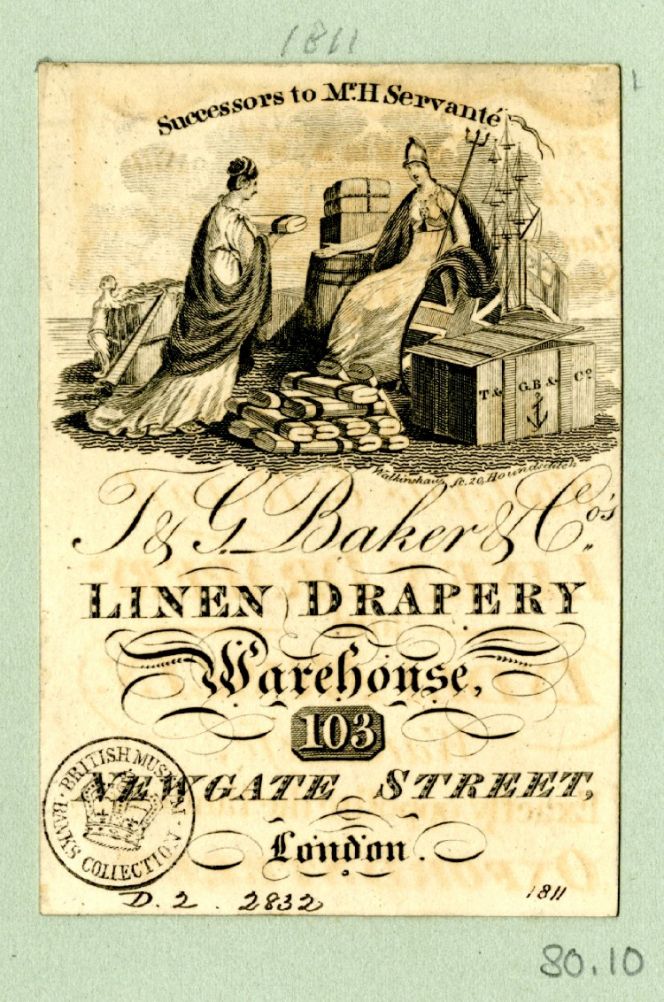 This trade card dated 1811 from a London linen draper is primarily emphasising the importance of trade and the British Empire with its standardised Imperial motif. But secondarily all sorts of parcels, boxes and barrels are included – demonstrating the way fabrics and other goods were transported before it reached the shops. Courtesy of: © Trustees of the British Museum, Trade cards, Banks 80.10. (Collection online).
This trade card dated 1811 from a London linen draper is primarily emphasising the importance of trade and the British Empire with its standardised Imperial motif. But secondarily all sorts of parcels, boxes and barrels are included – demonstrating the way fabrics and other goods were transported before it reached the shops. Courtesy of: © Trustees of the British Museum, Trade cards, Banks 80.10. (Collection online).Boxes, barrels, hides, or protective coarser fabrics had for centuries been the most important water-tight wrapping methods for keeping delicate fabrics and other textile accessories dry during long transports, whilst paper was more widely introduced in the second half of the 1700s in shops. One such early observation about paper parcels can be studied from a publication printed in 1745 (The Harleian Miscellany…p 339), which stated that: ‘Brown or Wrapping-paper, unfit for Writing, and only used to make Covers for the other Paper, and to wrap up Goods, therefore called Shop-Paper’. Evidently, wrapping paper was used during the whole period of the long 19th century – 1789 to 1914 – for parcels of drapery goods, among many other forms of merchandise.
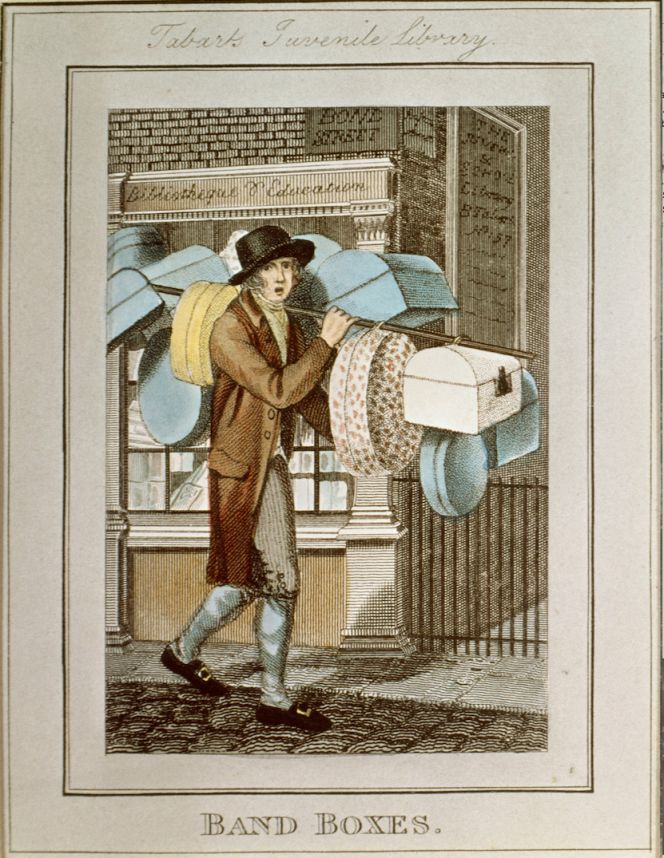 Rare illustration of a selection of box models for bands and a handy transport method with a rod, probably depicting a London errand boy/seller. Print and hand-coloured copperplate engraving 1804 by Edward Williams, William Marshall Craig & Richard Phillips. Courtesy of: Museum of London. (35.96/15, Electronic Source).
Rare illustration of a selection of box models for bands and a handy transport method with a rod, probably depicting a London errand boy/seller. Print and hand-coloured copperplate engraving 1804 by Edward Williams, William Marshall Craig & Richard Phillips. Courtesy of: Museum of London. (35.96/15, Electronic Source).Bands or ribbons formed a noteworthy component for clothing for centuries in many cultures; which was not only used as decoration but also to hide and reinforce seams, tie together parts of garments, hold up stockings, etc. Many of these ribbons were made of expensive silk with metallic threads or fine cotton, linen, and woollen types. All needed to be protected during transport, not only by the individual customer in small parcels but also by the seller/errand boy for the needs of the shop, which this coloured illustration above is a unique example of.
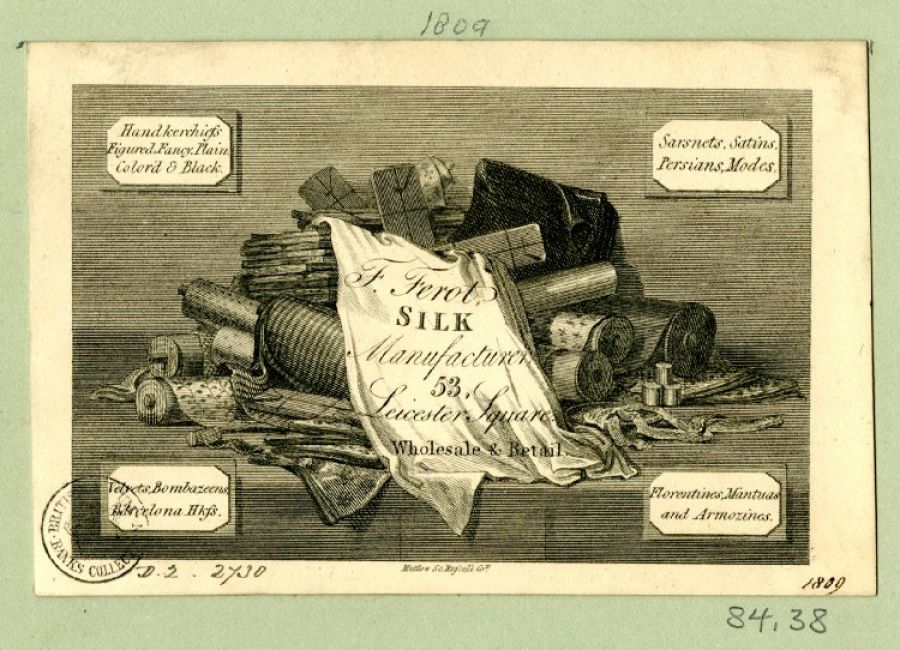 This London trade card dated 1809 in pencil has a rare design showing such close-up details of fabrics, silk reels, ribbons of silk and wrapped paper parcels tied with a string. Courtesy of: © Trustees of the British Museum, Trade cards, Banks 84.38. (Collection online).
This London trade card dated 1809 in pencil has a rare design showing such close-up details of fabrics, silk reels, ribbons of silk and wrapped paper parcels tied with a string. Courtesy of: © Trustees of the British Museum, Trade cards, Banks 84.38. (Collection online).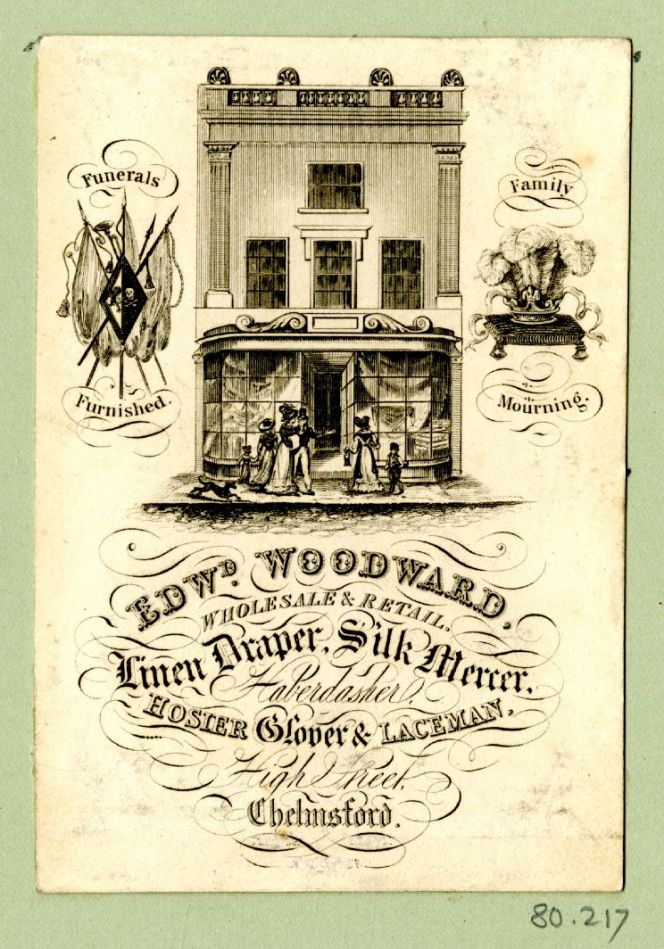 Undated trade card depicting prospective customers outside a linen draper etc in Chelmsford ca 1810s-1820s. This was not an unusual design for a trade card in the early 1800s, but what is particular is that it looks like the small boy is carrying a rectangular parcel for his mother! Courtesy of: © Trustees of the British Museum, Trade cards, Banks 80.217. (Collection online).
Undated trade card depicting prospective customers outside a linen draper etc in Chelmsford ca 1810s-1820s. This was not an unusual design for a trade card in the early 1800s, but what is particular is that it looks like the small boy is carrying a rectangular parcel for his mother! Courtesy of: © Trustees of the British Museum, Trade cards, Banks 80.217. (Collection online).There is evidence, too, that “parcels” in advertisements during the late 19th century not only referred to a wrapped paper parcel, but sometimes instead to a bundle of fabric. Here are a few examples of the different definitions from Whitby Gazette:
- In the spring of 1880, the draper John Wompra announced ‘Declining Business, A Rare Opportunity to Buy a Cheap Parcel [bundle] of Drapery…' Whilst Mrs Peacock, in the same spring, announced: ‘Wanted to purchase Cast-Off Clothing of any description in town or country. Parcels forwarded promptly acknowledged. Cash paid at once, by Mrs. J.E. Peacock, Church Street, near Cholmley School, Whitby’. How these parcels were wrapped is unclear.
- In 1890, the linen & woollen drapers Wellburn Brothers instead advertised for a strong youth to work as an ‘Errand Boy’. The censuses of 1891, 1891, 1901, and 1911 from the Whitby/Ruswarp districts list a few errand boys in the drapery and clothier trade. One of their tasks must have been to deliver parcels to customers – local inhabitants and long-term hotel visitors alike.
- Another enlightening advertisement in this newspaper originates from 20 January 1905, describing a ‘Great Clearance Sale’ by ‘Dickson & Benson, Ltd., The Arcade & Linthorpe Road, Middlesbro’, with a detailed description of a wide variety of clothes, accessories and domestic linen. Readers from Whitby were offered a special incentive including a mention of parcels – probably wrapped in paper: ‘The whole advantages and opportunities offered at this Sale are available to residents in Whitby as though they were close neighbours in Middlesbrough. For ever purchase over £1 Single Railway fare is allowed. For over £2 Full Return Fare. Moreover, your letters get every attention. Carriage is paid on all parcels. Patterns sent of everything with Pleasure.’
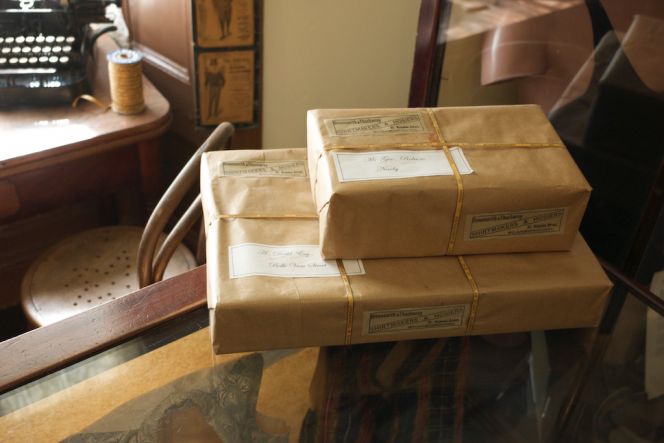 These parcels demonstrate how the ready-made garments as well as pieces of cloth could be delivered to customers in the 1890s to early 1900s from a draper shop. Beck Isle Museum of Rural Life, Pickering; Reconstruction of an original tailor’s shop interior from ‘Greensmith & Thackwray in Scarborough, founded in 1845. Photo: The IK Foundation, London.
These parcels demonstrate how the ready-made garments as well as pieces of cloth could be delivered to customers in the 1890s to early 1900s from a draper shop. Beck Isle Museum of Rural Life, Pickering; Reconstruction of an original tailor’s shop interior from ‘Greensmith & Thackwray in Scarborough, founded in 1845. Photo: The IK Foundation, London.A brief study of artworks, coloured prints and photographs depicting department stores, draperies and similar establishments in 19th century England also shows that it is difficult to find customers actually carrying parcels of any sort when shopping. The same conclusion may be drawn from my earlier research into illustrations giving evidence for various angles of shopping and material culture. This is probably due to the fact that relatively wealthy people who used to be the focal point for such depictions rarely or never carried their own purchased goods in real life – caused by the widespread tradition in the Victorian and Edwardian periods of getting all sorts of purchases delivered in parcels or boxes to one’s home address by errand boys.
Sources:
- British Museum, Collection Online (Search words: 'trade cards textile').
- Hansen, Viveka, The Textile History of Whitby 1700-1914 – A lively coastal town between the North Sea and North York Moors, London & Whitby 2015 (Ch. III).
- Oldys, William, The Harleian Miscellany, Or, A Collection of Scarce, Curious, and …, Volume 3, Oxford 1745.
- Whitby Gazette, 1880-1905 (Whitby Museum, Library & Archive).
Essays
The iTEXTILIS is a division of The IK Workshop Society – a global and unique forum for all those interested in Natural & Cultural History from a textile Perspective.
Open Access essays, licensed under Creative Commons and freely accessible, by Textile historian Viveka Hansen, aim to integrate her current research, printed monographs, and earlier projects dating back to the late 1980s. Some essays feature rare archive material originally published in other languages, now available in English for the first time, revealing aspects of history that were previously little known outside northern European countries. Her work also explores various topics, including the textile trade, material culture, cloth manufacturing, fashion, natural dyeing, and the intriguing world of early travelling naturalists – such as the "Linnaean network" – viewed through a global historical lens.
For regular updates and to fully utilise iTEXTILIS' features, we recommend subscribing to our newsletter, iMESSENGER.
been copied to your clipboard




– a truly European organisation since 1988
Legal issues | Forget me | and much more...
You are welcome to use the information and knowledge from
The IK Workshop Society, as long as you follow a few simple rules.
LEARN MORE & I AGREE







